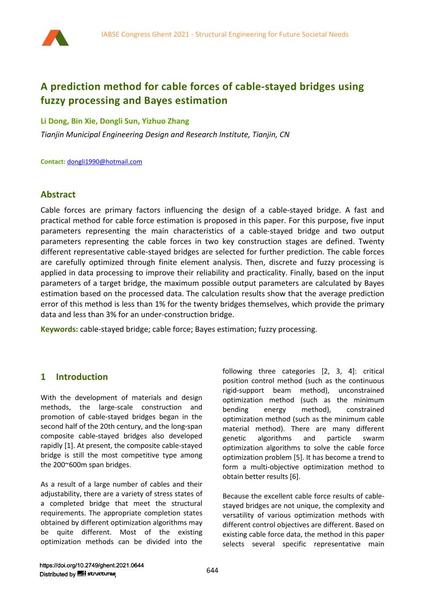A prediction method for cable forces of cable-stayed bridges using fuzzy processing and Bayes estimation

|
|
|||||||||||
Bibliographic Details
| Author(s): |
Li Dong
(Tianjin Municipal Engineering Design and Research Institute, Tianjin, CN)
Bin Xie (Tianjin Municipal Engineering Design and Research Institute, Tianjin, CN) Dongli Sun (Tianjin Municipal Engineering Design and Research Institute, Tianjin, CN) Yizhuo Zhang (Tianjin Municipal Engineering Design and Research Institute, Tianjin, CN) |
||||
|---|---|---|---|---|---|
| Medium: | conference paper | ||||
| Language(s): | English | ||||
| Conference: | IABSE Congress: Structural Engineering for Future Societal Needs, Ghent, Belgium, 22-24 September 2021 | ||||
| Published in: | IABSE Congress Ghent 2021 | ||||
|
|||||
| Page(s): | 644-652 | ||||
| Total no. of pages: | 9 | ||||
| DOI: | 10.2749/ghent.2021.0644 | ||||
| Abstract: |
Cable forces are primary factors influencing the design of a cable-stayed bridge. A fast and practical method for cable force estimation is proposed in this paper. For this purpose, five input parameters representing the main characteristics of a cable-stayed bridge and two output parameters representing the cable forces in two key construction stages are defined. Twenty different representative cable-stayed bridges are selected for further prediction. The cable forces are carefully optimized through finite element analysis. Then, discrete and fuzzy processing is applied in data processing to improve their reliability and practicality. Finally, based on the input parameters of a target bridge, the maximum possible output parameters are calculated by Bayes estimation based on the processed data. The calculation results show that the average prediction error of this method is less than 1% for the twenty bridges themselves, which provide the primary data and less than 3% for an under-construction bridge. |
||||
| Keywords: |
cable-stayed bridge cable force Bayes estimation fuzzy processing
|
||||
| Copyright: | © 2021 International Association for Bridge and Structural Engineering (IABSE) | ||||
| License: | This creative work is copyrighted material and may not be used without explicit approval by the author and/or copyright owner. |
||||

